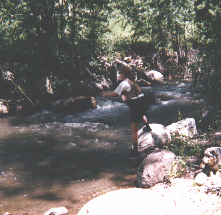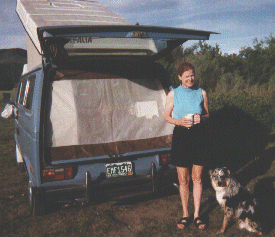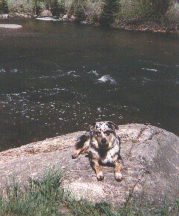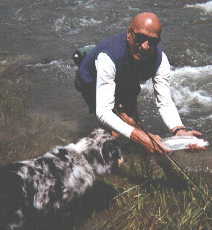My fishing companion, Sue, was invited to participate in a geologic field trip to
Montana which brought with it the opportunity to do a little bit of early season casting
in that state for both of us. We loaded up the blue box (a 1982 VW Vanagon) &
gingerly made our way up the Interstate through Billings, on through Bozeman, and to
the destination in the Tobacco Root Mountains.
Being late in June, the chance that runoff had abated was fairly slim and that proved
to be the case when we took a look at the Yellowstone just upstream from Billings.
But near Bozeman we encountered relatively normal flow conditions on Bridger Creek  and enjoyed a
few hours of catching and releasing numbers of moderate sized rainbows on small caddis or
stone nymphs. The East Gallatin also was clear and fairly wadable, but since it was
the weekend, all the normal access points were clogged with fishermen, and we passed on
trying it.
and enjoyed a
few hours of catching and releasing numbers of moderate sized rainbows on small caddis or
stone nymphs. The East Gallatin also was clear and fairly wadable, but since it was
the weekend, all the normal access points were clogged with fishermen, and we passed on
trying it.
The main Gallatin was also raging when we drove over it near Manhatton. A few
attempts we made with wooly buggers in some eddies went for naught.
That night we camped on the lower Madison near Cherry Creek  where
we'd had some success the previous summer. Although small hatches of a white caddis
& an alloperla stone were in progress, we had no luck that evening attempting to match
the emergers or adults, nor did we fare any better with bank yanked wooly buggers.
where
we'd had some success the previous summer. Although small hatches of a white caddis
& an alloperla stone were in progress, we had no luck that evening attempting to match
the emergers or adults, nor did we fare any better with bank yanked wooly buggers.
Next day we traveled up a gravel road to the geology headquarters on the South Boulder
River above Cardwell. It's pretty rugged country with some small ranches in the
narrow valley and range cattle roaming everywhere. That we were truly in the
backwoods was evidenced by the reports of both bear and moose sightings the first day we
arrived. The second day brought the discovery of a freshly killed range steer - by a
mountain lion - only a few hundred yards from camp.
 The South Boulder was clear, but swollen from snow melt. Unfortunately
the stream drops very sharply through the length of the valley and high water levels plus
the brushy bank made any kind of wading out of the question. I did land a 13"
brown in a micro eddy that day on a wooly bugger, but that was it. The next day's
trip several miles upstream brought only negative results.
The South Boulder was clear, but swollen from snow melt. Unfortunately
the stream drops very sharply through the length of the valley and high water levels plus
the brushy bank made any kind of wading out of the question. I did land a 13"
brown in a micro eddy that day on a wooly bugger, but that was it. The next day's
trip several miles upstream brought only negative results.
It was a repeat of no success the following day when I drove up the Jefferson to take a
look at the Ruby & Beaverhead Rivers. Waters were murky everywhere and I had no
strikes working the banks. This was getting depressing.
Our last day at camp did bring better results. The Boulder had dropped slightly,
opening up a few more casting locations near camp, and I was able to land 6-8 fish mixed
between rainbows & browns using caddis emergers and a black diving caddis - both
fished close to the bottom. Interestingly the browns appeared chunkier than the bows
and were definitely better fighters.
Heading back towards Colorado the next morning we drove up the Madison, camping that
night at the McAfee Bridge put in. But the following morning still brought no luck
with buggers by the bank. Our luck changed later in the day. Upstream above
the West Madison we finally began taking browns on buggers. We missed numbers of
strikes plus finally saw some larger fish, and it got even better shortly.
When drove down the gravel road where the Madison enters Hebgen Lake , we
finally found a kind of fishing nirvana. The wild pocket water was slightly murky
and running high, but we had great success on sleek, fat rainbows and the always plentiful
whitefish close to the lake and for a mile or so above it. The fish took golden or
black stone nymphs or cone headed wooly buggers fished nymph fashion behind the many
boulders in mid stream. It wasn't easy fishing. Sue landed the best fish here
- a whopper of a 22" rainbow. My best was about 16''. We departed with
big grins.
, we
finally found a kind of fishing nirvana. The wild pocket water was slightly murky
and running high, but we had great success on sleek, fat rainbows and the always plentiful
whitefish close to the lake and for a mile or so above it. The fish took golden or
black stone nymphs or cone headed wooly buggers fished nymph fashion behind the many
boulders in mid stream. It wasn't easy fishing. Sue landed the best fish here
- a whopper of a 22" rainbow. My best was about 16''. We departed with
big grins.
Below the lake, as we were crossing the bridge to head into Idaho, we stopped for a few
minutes in the heavily fished area right above the bridge and I caught my best fish of the
trip - a steelhead sized rainbow of roughly 22-23 inches. It took a #14 dark stone.
In Idaho we'd hoped to spend a bit of time on one of our very favorites - Grayling
Creek - but I took a wrong turn, and we missed the stream completely. That night we
camped on the Henry's Fork near Ashton. It was fun watching the caddis hatch that
evening and seeing the fish rise to them. Again we caught nice rainbows on nymphs
before journeying back through Wyoming the following morning. As it would be our
last day on the road, we took a quick shot at the Colorado strain cutthroats which
apparently inhabit LaBarge Creek. No success on that count as the water was raging.
One small rainbow took a stonefly nymph. That was it for the fishing.
Overall the trip really offered marginal fishing, but the nice scenery and an
opportunity to acquire new streamcraft skills always makes for a winning combination.
There are no bad days on the water.
 and enjoyed a
few hours of catching and releasing numbers of moderate sized rainbows on small caddis or
stone nymphs. The East Gallatin also was clear and fairly wadable, but since it was
the weekend, all the normal access points were clogged with fishermen, and we passed on
trying it.
and enjoyed a
few hours of catching and releasing numbers of moderate sized rainbows on small caddis or
stone nymphs. The East Gallatin also was clear and fairly wadable, but since it was
the weekend, all the normal access points were clogged with fishermen, and we passed on
trying it. where
we'd had some success the previous summer. Although small hatches of a white caddis
& an alloperla stone were in progress, we had no luck that evening attempting to match
the emergers or adults, nor did we fare any better with bank yanked wooly buggers.
where
we'd had some success the previous summer. Although small hatches of a white caddis
& an alloperla stone were in progress, we had no luck that evening attempting to match
the emergers or adults, nor did we fare any better with bank yanked wooly buggers. The South Boulder was clear, but swollen from snow melt. Unfortunately
the stream drops very sharply through the length of the valley and high water levels plus
the brushy bank made any kind of wading out of the question. I did land a 13"
brown in a micro eddy that day on a wooly bugger, but that was it. The next day's
trip several miles upstream brought only negative results.
The South Boulder was clear, but swollen from snow melt. Unfortunately
the stream drops very sharply through the length of the valley and high water levels plus
the brushy bank made any kind of wading out of the question. I did land a 13"
brown in a micro eddy that day on a wooly bugger, but that was it. The next day's
trip several miles upstream brought only negative results. , we
finally found a kind of fishing nirvana. The wild pocket water was slightly murky
and running high, but we had great success on sleek, fat rainbows and the always plentiful
whitefish close to the lake and for a mile or so above it. The fish took golden or
black stone nymphs or cone headed wooly buggers fished nymph fashion behind the many
boulders in mid stream. It wasn't easy fishing. Sue landed the best fish here
- a whopper of a 22" rainbow. My best was about 16''. We departed with
big grins.
, we
finally found a kind of fishing nirvana. The wild pocket water was slightly murky
and running high, but we had great success on sleek, fat rainbows and the always plentiful
whitefish close to the lake and for a mile or so above it. The fish took golden or
black stone nymphs or cone headed wooly buggers fished nymph fashion behind the many
boulders in mid stream. It wasn't easy fishing. Sue landed the best fish here
- a whopper of a 22" rainbow. My best was about 16''. We departed with
big grins.